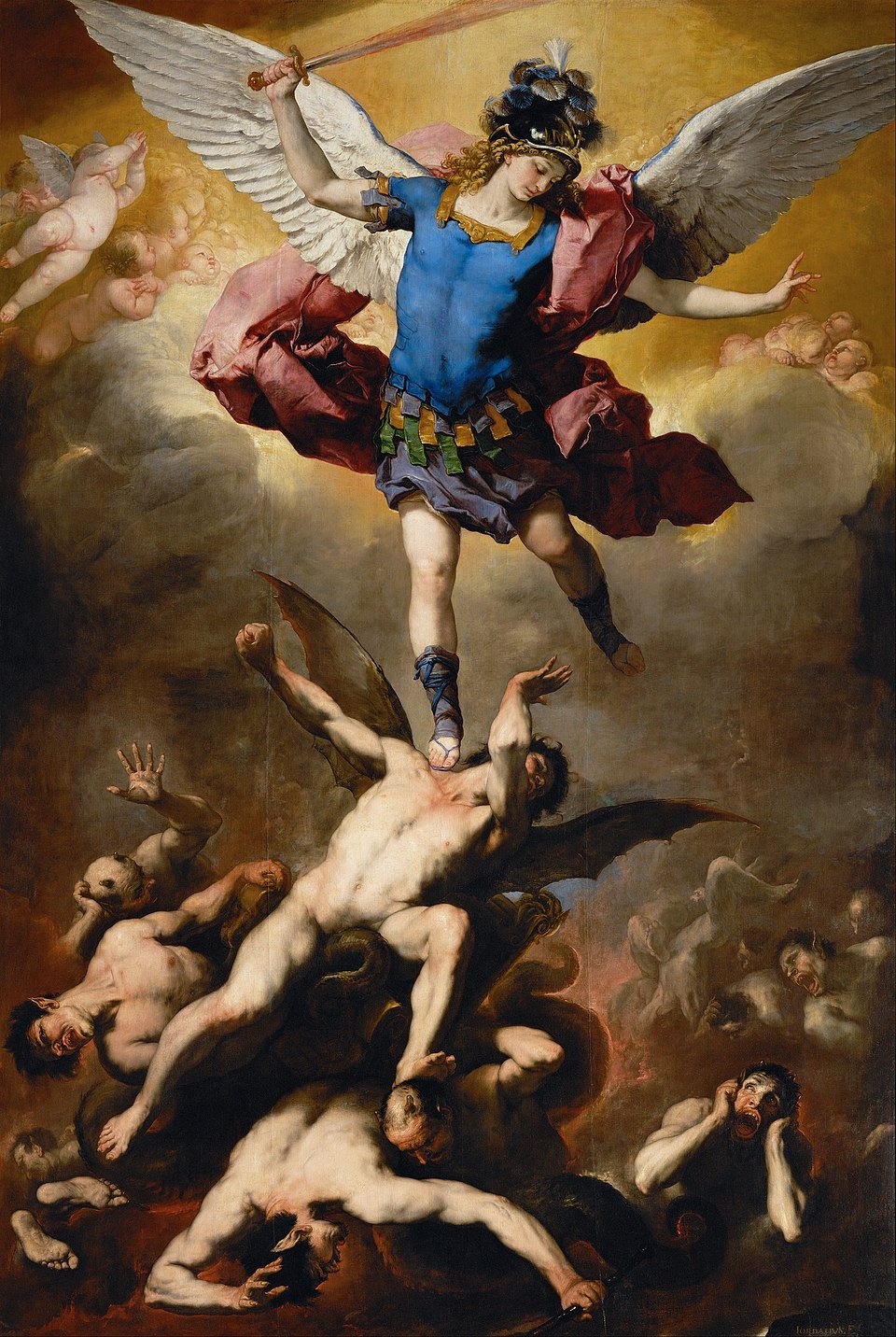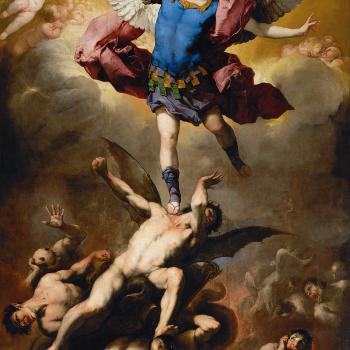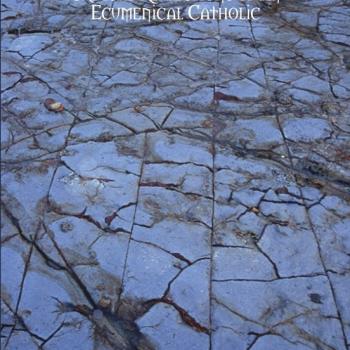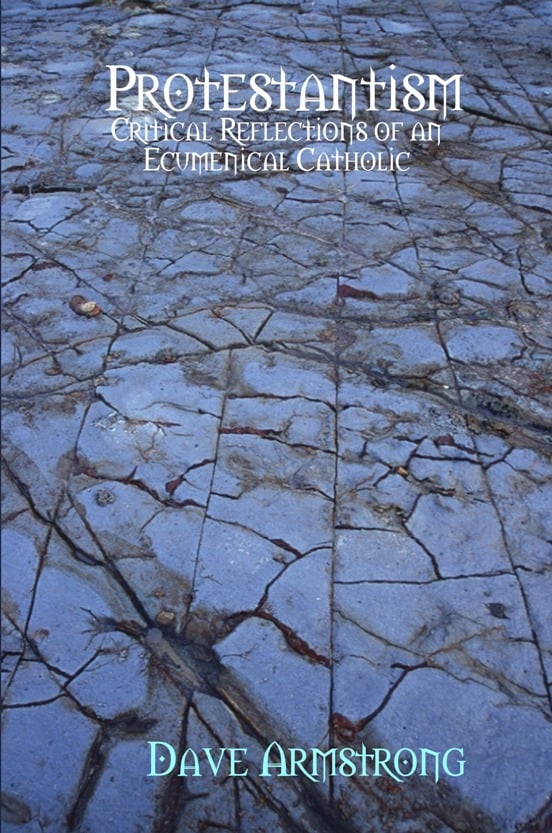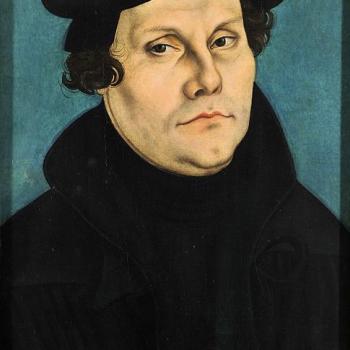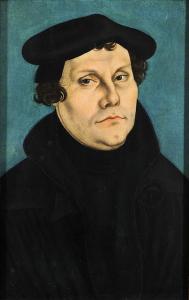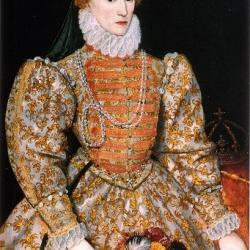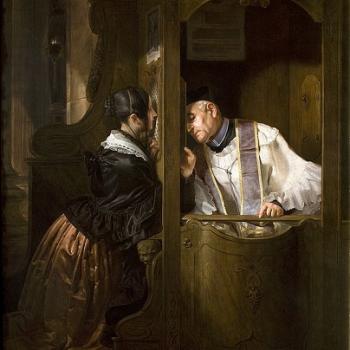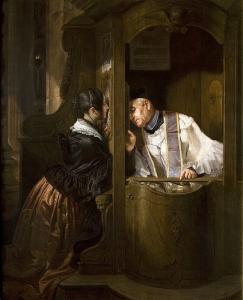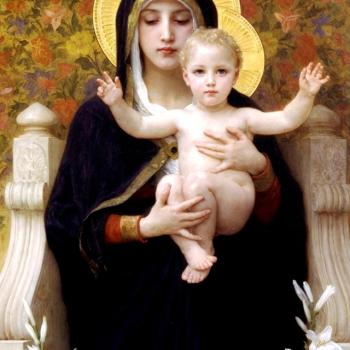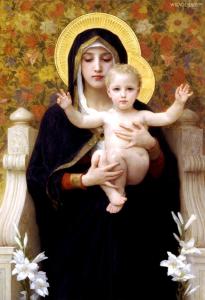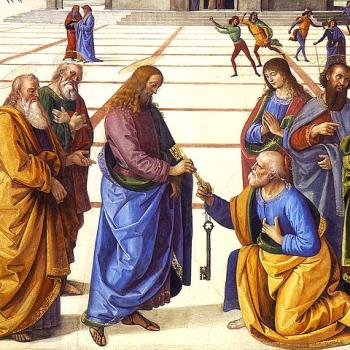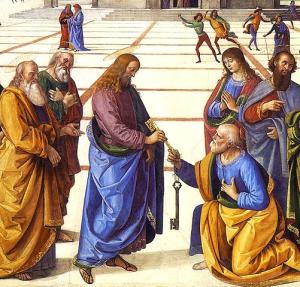
Lucas Banzoli is a very active Brazilian anti-Catholic polemicist, who holds to basically a Seventh-day Adventist theology, whereby there is no such thing as a soul that consciously exists outside of a body, and no hell (soul sleep and annihilationism). This leads him to a Christology which is deficient and heterodox in terms of Christ’s human nature after His death. He has a Master’s degree in theology, a degree and postgraduate work in history, a license in letters, and is a history teacher, author of 27 self-published books, as well as blogmaster for six blogs. He has many videos on YouTube.
This is my 65th refutation of Banzoli’s writings. From 25 May until 12 November 2022 he wrote not one single word in reply, claiming that my articles were “without exception poor, superficial and weak” and that “only a severely cognitively impaired person” would take them “seriously.” Nevertheless, he found them so “entertaining” that after almost six months of inaction he resolved to “make a point of rebutting” them “one by one”; this effort being his “new favorite sport.”
He has now replied to me 16 times (the last one dated 2-20-23). I disposed of the main themes of his numberless slanders in several Facebook posts under his name on my Anti-Catholicism page (where all my replies to him are listed). I shall try, by God’s grace, to ignore his innumerable insults henceforth, and heartily thank him for all these blessings and extra rewards in heaven (Matthew 5:11-12).
Google Translate is utilized to render Lucas’ Portugese into English. Occasionally I slightly modify clearly inadequate translations, so that his words will read more smoothly and meaningfully in English. I use the RSV for both my Bible citations and Banzoli’s. His words will be in blue.
*****
This is a reply to Lucas Banzoli’s article, “Refutando todas as calúnias católicas contra a rainha Isabel da Inglaterra” [Refuting all Catholic slanders against Queen Elizabeth of England] (4-13-18).
. . . the religious field, in which Elizabeth put an end to the terror spread by her late sister . . .
Elizabeth did not make any kind of radical Protestant or anti-Catholic monarch, much less a tyrant who forced conversions or killed in the name of the faith. In fact, a large part of her enormous popularity in England was precisely due to this moderation that always kept her away from any religious persecution along the lines of her bloodthirsty sister. . . .
Catholics, whether nobles or not, continued to exist throughout the entire Elizabethan period, but by the end of their rule “they hardly formed the twentieth part of the population” – even without any massacre, any auto-da -faith, no Inquisition and no obligation to stop being Catholic in order to stay alive. . . .
She was . . . not a violent, bloodthirsty or warlike queen, but exceptionally tolerant by the standards of the time, pacifist and religiously moderate, which won the loyalty and loyalty of even her most Catholic subjects. . . .
Elizabeth is accused of killing “hundreds of Catholics” over her 45 years of reign. In fact, a derisory number of Catholics were executed, equivalent to four for each year of reign [that would be 180], but none of them for “heresy” or for the “crime” of expressing their religious opinions. Instead, this number consists fundamentally of Jesuits sent to England on the specific mission of carrying out the “undertaking”, where Elizabeth would end up murdered and dethroned, and Mary Stuart would assume the crown in her place. . . .
In short, what is known to any historian or serious scholar is that Elizabeth did not persecute any Catholic for religious convictions, nor did she impose any opposition to freedom of conscience, things that the Queen, famous for her moderation, abhorred. All she did was punish some Jesuits infiltrated in England with the specific mission of conspiring, raising the country through rebellions and betrayals, inciting political sabotage and finally murdering her . . .
It is extremely important to note that during the entire first decade of her reign (i.e., the period before Pope Pius V’s Bull, the Northern Revolt, and the plots to assassinate the Queen) there was no death sentence in England. This fact is extremely significant, as it supports the historical fact that Elizabeth was not a religiously intolerant queen with an interest in punishing Catholics for the “crime” of heresy . . .
Mary reigned for five years and killed 300 Protestants for heresy, while Elizabeth reigned for ten years without condemning anyone to capital punishment, and when she began to condemn, she did so for high treason, not for doctrinal reasons. Isabel’s numbers point to 187 executions (123 of which were Jesuit “missionaries”) throughout her 45 years of reign, which is equivalent to four individuals per year . . .
Elizabeth’s England had no laws against heresy, no ecclesiastical courts judging people’s faith, no autos-da-fé, no public ceremonies for burning heretics, no restrictions on freedom of conscience, and no one was obligated ( although there was an incentive) to be a Protestant. What did exist, as everywhere else, was capital punishment (on the gallows or by decapitation) for those who committed the crime of high treason, in which the convicted Jesuits were, by far, the greatest professionals.
***
Well, we’ve had enough of lies and propaganda. Now how about historical truth, as best we can ascertain it? Banzolis view is that Bloody Queen Bess “reigned for ten years [1558-1568] without condemning anyone to capital punishment, and when she began to condemn, she did so for high treason, not for doctrinal reasons.” What I will proceed to massively demonstrate is that this is simply not true. The following is an abridged version of the documented information contained in 312 Catholic Martyrs & Confessors Under “Good Queen Bess” (Queen Elizabeth: r. 1558-1603) [2-8-08].
See that article for much fuller accounts. I will provide documentation of 512 Catholic martyrs under Bloody Queen Bess: the vast majority of them named. The former article didn’t provide links (usually from Catholic Encyclopedia or Wikipedia) about each martyr. They will be added below. The martyrs are listed chronologically by date of execution. Elizabeth ruled over the entirety of Ireland as well as England.
Queen Elizabeth is often regarded as a tolerant queen, yet during her reign (17 November 1558 – 24 March 1603), there were 302 executions –not counting ten executed members of the Northern Rising of 1569 — (most involving horrible prolonged tortures) or confessors’ deaths rotting away or starving to death or tortured to death in prisons for the “treasonous crime” of being Catholic. That is counting English victims only. But there were also about 210 Irish victims, for a grand total of at least 512 martyrs of the Catholic faith under “Good Queen Bess”. Henry VIII averaged about 16 executions or horrible starving deaths of Catholics a year, after he started murdering them in 1534.
Elizabeth averaged almost 12 per year for her entire 44 years and 4 months reign. Thus she showed herself on average to be about 75% as savage and vicious as her illustrious father, in terms of the frequency and rate of the butchery. After 1585 it was “treason” to be a priest and to set foot in England at all. Banzoli wants to make out that the charges of “treason” were only against wicked Catholics (mostly all the dreaded and despised Jesuit priests, of course) conspiring to murder their murderous queen. It’s simply not so. Keep reading if you doubt this. Facts have a marvelous ability to absolutely obliterate lies and myths.
Richard Coppinger: Benedictine. Died in prison in 1558.
Bishop Ralph Bayle: Died on 18 November 1559 in prison. He was one of eleven bishops whom Bloody Queen Bess deprived and left to die in prison.
Bishop Cuthbert Turnstall (or, Tunstall): Died on 18 November 1559 in prison.
Bishop Owen Oglethorpe: Died on 31 December 1559 in prison.
Thomas Slythurst: Priest. Died in the Tower of London, 1560.
Bishop John White: Died on 12 January, 1560 in prison.
William Chedsey: Priest. Died in a London prison in 1561.
Sir Edward Waldegrave: Layman. Died in a London prison in 1561.
Agnes Johnson: Laywoman. Died in a York prison in 1561.
John Fryer (or, Frier): Layman. Died in a London prison in 1563.
Bishop Richard Pate: Died on 23 November 1565 in prison.
Bishop David Poole: Died in May, 1568 in prison.
Bishop Edmund Bonner: When Elizabeth ascended to the throne he was ordered to resign, which he refused to do, adding that he preferred death. On 20th April, 1560, he was sent as a prisoner to the Marshalsea. When the Parliament of 1563 met, a new Act was passed by which the first refusal of the oath of royal supremacy was praemunire, the second, high treason. On 29th April, 1564 the oath was again tendered to Bonner by Horne, the Anglican Bishop of Winchester. This he firmly refused. Four times a year for three years he was forced to in the courts at Westminster only to be further remanded. The end came on 5th September, 1569, when he died in the Marshalsea.
Bishop Gilbert Bourne: During his brief episcopate he laboured zealously for the restoration of the Catholic religion, although towards heretics, as even Godwin, a Protestant, admits, he always used kindness rather than severity, nor do any seem to have been executed in his diocese. On his rejection of the Supremacy Oath, on 18 October, 1559, and his deprivation followed, [when he] was committed on 18 June a close prisoner to the Tower, . . . Thus began that continual “tossing and shifting” of the deposed prelates “from one keeper to another, from one prison to another”, . . . After nearly ten years of this suffering existence Bishop Bourne expired 10 September, 1569, at Silverton in Devonshire.
Anthony Draycott: Priest. Died in a London prison in 1570.
Blessed John Felton: On 24 or 25 May 1570, Felton affixed a copy of the Bull of St. Pius V excommunicating the queen to the gates of the Bishop of London’s palace near St. Paul’s. On 26 May 1570 he was arrested and taken to the Tower, where he was thrice racked, though he from the first confessed and gloried in his deed. He was condemned on 4 August and executed in St. Paul’s Churchyard, London on 8 August, 1570. He was cut down alive, and his heart was cut out.
Bishop Thomas Thurlby (or, Thirlby): Died in prison on 26 August, 1570.
Bishop James Thurberville (or, Turberville): Died in prison on 1 November 1570.
John Boxall: Priest. Died in a London prison in 1571.
Nicholas Grene: Priest. Died in a York prison in 1571.
Blessed John Story (or, Storey): When Queen Mary was on the throne, Story was one of her most active agents in prosecuting heretics, and was one of her proctors at the trial of Cranmer at Oxford in 1555. In 1560 he opposed the Bill of Supremacy , and incurred the ire of Queen Elizabeth. In August 1570, he was locked in the Tower of London and repeatedly tortured (including racking). Indicted on 26 May 1571 for conspiring against the Queen’s life. Throughout his misery, John bore his tortures with fortitude and claimed his innocence. He was hanged, drawn, and quartered at Tyburn on the 1st of June 1571.
Thomas Sedgwick: Priest. Died in a Yorkshire prison in 1573.
Blessed Thomas Woodhouse: Priest. On 14 May, 1561, he was committed to the Fleet, London, having been arrested while saying Mass. For the rest of his life he remained in custody, but [was] treated with considerable leniency till on 19 November, 1572, he sent the prison washerwoman to Lord Burghley’s house with his famous letter. In it he begs him to seek reconciliation with the pope and earnestly to “persuade the Lady Elizabeth, who for her own great disobedience is most justly deposed, to submit herself unto her spiritual prince and father”. He was executed at Tyburn on 19 June, 1573, being disemboweled alive.
Thomas Gabyt: Cistercian. Executed in 1575.
Nicholas Harpsfield: Priest. Died in a London prison in 1575.
St. Cuthbert Mayne: Priest. On April 24, 1576, he left for the English mission. Elizabeth I’s agents quickly became aware of Mayne’s presence in the area and the authorities began a systematic search for him in June. The high sheriff, Sir Richard Grenville, discovered a Catholic devotional article, an Agnus Dei round Mayne’s neck, and took him into custody. The jury found Mayne guilty of high treason on all counts. He kissed a copy of the bible, declaring that, “the queen neither ever was, nor is, nor ever shall be, the head of the church of England” [and] was executed on November 29, 1577. It is unclear if he died on the gibbet. In any case, he was unconscious during the disemboweling.
Blessed John Nelson: Jesuit. Executed at Tyburn on February 3, 1578 . . . hung and cut down alive, his heart cut out, then quartered.
Blessed Thomas Nelson: Jesuit student. Hanged, drawn, and quartered at Tyburn on February 3, 1578.
[See the Wikipedia article for a gruesome description of the English punishment of being hanged, drawn, and quartered]
Bishop Nicholas Heath: Archbishop of York. Died in prison in December 1578.
Thomas Layne: Layman. Died in a York prison in 1579.
Blessed Thomas Sherwood: Layman. Racked with a view to extracting details of houses where Mass was celebrated, Thomas kept silent. As a result he was then thrown into a dungeon to rot, and the inevitable sentence of hanging, drawing and quartering was carried out at Tyburn on February 7, 1579.
Henry Cole: Priest. During Elizabeth’s reign he remained true to the Catholic Faith . . . committed to the Tower (20 May, 1560), and finally removed to the Fleet (10 June), where he remained for nearly twenty years, until his death in February 1579 (or February 1580).
Mr. Ailworth (or, Aylword): Admitted Catholics to Mass at his house; was arrested, and died after eight days, 1580.
John Cooper: Probably a distributor of Catholic books, arrested at Dover and sent to the Tower, died of “hunger, cold, and stench”, 1580.
Robert Dimock (or, Dymoke): Arrested at Mass, and perished after a few weeks’ imprisonment at Lincoln, 11 September, 1580.
John Molineaux: Layman. Died in a London prison in 1581.
John Constable: Layman. Died in a York prison in 1581.
Blessed Everald Hanse: Priest. He was asked in court at the Newgate Sessions, what he thought of the pope’s authority, and on his admitting that he believed him “to have the same authority now as he had a hundred years before”, he was further asked whether the pope had not erred (i.e. sinned) in declaring Elizabeth excommunicate, to which he answered, “I hope not.” He was at once found guilty of “persuasion” which was high treason, and was executed at Tyburn on 31 July, 1581.
St. Alexander Briant: Priest. Placed under arrest on 28 April 1581, in the hope of extorting information. After fruitless attempts to this end at Counter Prison, London, he was taken to the Tower where he was subjected to excruciating tortures. To the rack, starvation, and cold was added the inhuman forcing of needles under the nails. He was arraigned on 16 November 1581, in Queen’s Bench, Westminster, on the charge of high treason, and condemned to death. The details of this last great suffering [hanged, drawn, and quartered], which occurred on the 1 December [1581] following, like those of the previous torture, are revolting. In his letter to the Jesuit Fathers he protests that he felt no pain during the tortures he underwent, and adds: “Whether this that I say be miraculous or no, God knoweth”.
St. Edmund Campion: Jesuit priest. He led a hunted life, preaching and ministering to Catholics in Berkshire, Oxfordshire, Northamptonshire, and Lancashire. On his way to Norfolk, he stopped at Lyford in Berkshire, where he preached on July 14 and the following day, by popular request. Here, he was captured by a spy and taken to London. Committed to the Tower of London, he was questioned in the presence of Elizabeth, who asked him if he acknowledged her to be the true Queen of England. He replied in the affirmative, and she offered him wealth and dignities, but on conditions which his conscience could not allow. (To reject his Catholic faith.) He was kept a long time in prison, twice racked (by order of the Council but certainly with Elizabeth’s consent), and every effort was made to shake his constancy. Despite the effect of a false rumour of retraction and a forged confession, his adversaries in despair summoned him to four public conferences (September 1, 18, 23 and 27, 1581). Tortured again on October 31, he was indicted at Westminster on a charge of having conspired, along with others, at Rome and Reims to raise a sedition in the realm and dethrone the Queen. The great saint stated at the close of his “trial”:
In condemning us, you condemn all your own ancestors — all the ancient priests, bishops, and kings — all that was once the glory of England, the island of saints, and the most devoted child of the See of Peter. For what have we taught, however you may qualify it with the odious name of treason, that they did not uniformly teach? To be condemned with these old lights — not of England only, but of the world — by their degenerate descendants, is both gladness and glory to us. God lives; posterity will live; their judgment is not so liable to corruption as that of those who are now going to sentence us to death.
He answered the sentence of the traitor’s death with the Te Deum laudamus, and, after spending his last days in prayer, was hanged, drawn and quartered at Tyburn on December 1, 1581.
St. Ralph Sherwin: Priest. On 9 November [1577] he was imprisoned in the Marshalsea, where he converted many fellow prisoners, and on 4 December was transferred to the Tower of London, where he was tortured on the rack and then laid out in the snow. He is said to have been personally offered a bishopric by Elizabeth I if he apostatised, but refused. After spending a year in prison he was finally brought to trial on a trumped up charge of treasonable conspiracy. On 1 December 1581 he was hanged, drawn and quartered at Tyburn.
St. John Payne: Early in July, 1581, he was arrested in Warwickshire through the efforts of the informer George “Judas” Eliot (a known criminal, murderer, rapist and thief, who made a career out of denouncing Catholics and priests for bounty). He was racked on August 14, and again on October 31. Paine was indicted at Chelmsford on March 22 on a charge of treason for conspiring to murder the Queen and her leading officers and install Mary, Queen of Scots on the throne. Paine denied the charges, and affirmed his loyalty to the Queen in all that was lawful (i.e., not contrary to his Catholicism or allegiance to the pope), contesting the reliability of the murderer Eliot. At his execution on the morning of the Monday April 2 [1582] he was dragged from prison on a hurdle to the place of execution and first prayed on his knees for almost half an hour and then kissed the scaffold, made a profession of faith and declared his innocence. The crowd had become so sympathetic to Paine that they hung on his feet to speed his death and prevented the infliction of the quartering until he was dead.
Blessed Thomas Ford: Priest. On July 17, 1581, he was arrested and on July 22nd of that same year, he was put in the Tower, where he was tortured. He was brought to court on November 16th with a faked charge of conspiracy. It said he had conspired in places he had never been (Rome and Rheims), on days he had been in England. Executed on May 28, 1582.
Blessed Robert Johnson: Priest. Racked on December 16, 1580 and put in a dungeon until his trial on November 14, 1581. He was condemned on November 20, and executed on May 28, 1582.
Blessed John Shert: Ordained in 1579. Executed on May 28, 1582.
Blessed Thomas Cottam: Convert and Jesuit. In June 1580 he was committed “close prisoner” to the Marshalsea. After being tortured, he was removed, 4 December, 1580, to the Tower, where he endured the rack and the “Scavenger’s Daughter”. On 30 May, 1582 he was drawn to Tyburn and executed.
Blessed William Filby: Priest. He was arrested in July 1581, committed to the Tower, removed 14 August to the Marshalsea, and thence back to the Tower again. He was sentenced 17 November, and from that date till he died was loaded with manacles. He was also deprived of his bedding for two months, and was executed at Tyburn, 30 May, 1582.
St. Luke Kirby: Convert and priest. In June of 1580, he was arrested on landing at Dover, and committed to the Gatehouse, Westminster. On December 4th, he was transferred to the Tower, where he was subjected to the “Scavenger’s Daughter” for more than an hour on December 9th. Kirby was condemned on November 17, 1581, and from April 2nd until the day he died [30 May 1582], he was put in irons.
Blessed Laurence Richardson: Priest. He was arrested in London in 1577 and imprisoned in Newgate, where he remained until the day of his indictment, 16 November, 1581, when he was committed to the Queen’s Bench Prison, and on the day of his condemnation, 17 November, to the Tower, where he had no bedding for two months. He was executed at Tyburn, 30 May, 1582.
Blessed Richard Kirkman: Priest. He was arrested on 8 August, 1582, and seems to have been arraigned a day or two after under 23 Eliz. c. 1. Executed at York on 22 August, 1582.
[The Act to retain the Queen’s Majesty’s subjects in their obedience (23 Eliz. c. 1), passed in 1581. This made it high treason to reconcile anyone or to be reconciled to “the Romish religion”
13 Eliz. c.1 made it high treason to affirm that the queen ought not to enjoy the Crown, or to declare her to be a heretic or schismatic; * 13 Eliz. c. 2, which made it high treason to put into effect any papal Bull of absolution, to absolve or reconcile any person to the Catholic Church, or to be so absolved or reconciled, or to procure or publish any papal Bull or writing whatsoever. The penalties of praemunire were enacted against all who brought into England or who gave to others “Agnus Dei” or articles blessed by the pope or by any one through faculties from him.
13 Eliz. c. 3, was designed to stop Catholics from taking refuge abroad, and declared that any subject departing the realm without the queen’s license, and not returning within six months, should forfeit the profits of his lands during life and all his goods and chattels.
An act against Jesuits, seminary priests, and such other like disobedient persons, (27 Eliz.1, c. 2) [1584] commanded all Roman Catholic priests to leave the country in 40 days or they be punished for high treason, unless within the 40 days they swore an oath to obey the Queen. Those who harbored them, and all those who knew of their presence and failed to inform the authorities would be fined and imprisoned, or where the authorities wished to make an example of them, they might be executed. This statute, under which most of the English martyrs suffered, made it high treason for any Jesuit or any seminary priest to be in England at all, and felony for any one to harbour or relieve them.]
Blessed William Lacey: Priest. After fourteen years’ persecution for his faith, which included imprisonment at Hull, and after the death of his wife, he went abroad and was ordained in 1580. On 10 May, 1581, he was at Loreto on his way to England. He was arrested after a Mass said by Thomas Bell, afterwards an apostate, in York Castle, 22 July, 1582. He suffered great hardships, being loaded with heavy irons, confined in an underground dungeon, and subjected to numerous examinations. He was arraigned on 11 August, probably under 13 Eliz. cc. 2 and 3. Executed at York on 22 August, 1582.
Blessed James Thompson (or, Hudson): Priest. He was arrested at York on 11 August, 1582. On being taken before the Council of the North he frankly confessed his priesthood. He was then loaded with double irons and was imprisoned, first in a private prison, then in the castle. On 25 November he was brought to the bar and condemned to the penalties of high treason. Three days later [28 November 1582] he suffered with great joy and tranquility at the Knavesmire, protesting that he had never plotted against the queen, and that he died in and for Catholic Faith. While he was hanging, he first raised his hands to heaven, then beat his breast with his right hand, and finally made a great sign of cross. In spite of his sentence, he was neither disemboweled nor quartered, but was buried under the gallows.
Thomas Ackridge: Franciscan. Died in prison in 1583.
Thurstan Arrowsmith: Layman. Died in prison in 1583.
James Laburne: Layman(?). Executed in 1583.
Thomas Mudde: Cistercian. Died in prison in 1583.
Blessed William Hart: Priest. He was betrayed by an apostate on Christmas Day, 1582, thrown into an underground dungeon, and put into double irons. Executed at York, 15 March, 1583.
Blessed Richard Thirkeld: Priest. On the eve of the Annunciation, 1583, he was arrested while visiting one of the Catholic prisoners in the Ousebridge Kidcote, York. The charge was one of having reconciled the queen’s subjects to the Church of Rome. He was found guilty on 27 May and condemned 28 May. Executed at York on 29 May, 1583.
Blessed John Bodley (or, Bodey): Convert and lay schoolmaster. Arrested in 1580, and spent three years in prison in Winchester. Hanged, drawn, and quartered on 2 November 1583 at Andover, England.
Blessed John Slade: Layman and schoolmaster. Hanged, drawn, and quartered on 2 November 1583 at Winchester, England.
Edward Arden: Born c. 1542. In 1583, Arden was indicted in Warwick for plotting against the life of the Queen and taken to London, where he was arraigned in the Guildhall, 16 December, 1583. He was convicted and was executed at Smithfield, 30 December, 1583. It is generally conceded that Arden was the innocent victim of a plot. He died protesting his innocence and declaring that his only crime was the profession of the Catholic religion.
Richard Hatton: Priest. Died in a London prison in 1583 or 1584.
Thomas Cotesmore
William Chaplain
Roger (or, Robert) Holmes
James Lomax
Roger Wakeman
Priests. Perished in prisons in 1584. Of Wakeman’s suffering several harrowing details are on record.
John Collins: Priest. Died in 1584.
Henry Comberford: Priest. Died in a York prison in 1584.
William Travers: Layman. Died in a London prison in 1584.
Thomas Watson: Bishop of Lincoln. Died after being held in Wisbeach Castle, in 1584.
Blessed William Carter: A lay printer. Among other Catholic books he printed a new edition (1000 copies) of Dr. Gregory Martin’s A Treatise of Schism, in 1580, for which he was at once arrested and imprisoned in the Gatehouse. He was transferred to the Tower in 1582. Having been tortured on the rack, he was indicted at the Old Bailey, 10 January 1584, for having printed Dr. Martin’s book, in which was a paragraph where confidence was expressed that the Catholic Hope would triumph, and pious Judith would slay Holofernes. This was interpreted as an incitement to slay the queen, though it obviously had no such meaning. He was executed for for treason at Tyburn on 11 January, 1584.
Blessed James Fenn (or, Feun): Priest. He was named a conspirator of a bogus assassination plot, and hanged, drawn, and quartered at Tyburn on February 12, 1584.
Blessed George Haydock: Priest. Hanged, drawn, and quartered at Tyburn on 12 February 1584. He acknowledged Elizabeth as his rightful queen, but confessed that he had called her a heretic. Haydock was alive when he was disemboweled.
Blessed Thomas Hemerford
Blessed John Munden
Blessed John Nutter
Priests. All hanged, drawn, and quartered at Tyburn on 12 February 1584.
Blessed James Bell: Priest. Hanged, drawn, and quartered at Lancaster on 20 April, 1584.
Blessed John Finch: Convert. His house was a centre of missionary work, he himself harbouring priests and aiding them in every way, besides acting as catechist. His zeal drew on him the hostility of the authorities, and at Christmas, 1581, he was entrapped and kept in the earl’s house as a prisoner, sometimes tortured and sometimes bribed in order to pervert him and induce him to give information. This failing, he was removed to the Fleet prison at Manchester and afterwards to the House of Correction. For many months he lay in a damp dungeon, ill-fed and ill-treated, desiring always that he might be brought to trial and martyrdom. After three years’ imprisonment, he was hanged, drawn, and quartered at Lancaster on 20 April, 1584.
John Feckenham: Benedictine, abbot of Westminster. Died in prison in 10 October 1584.
St. Richard White (or, Gwyn): In 1579 he was arrested by the Vicar of Wrexham, a former Catholic who had conformed to the new faith. He escaped and remained a fugitive for a year and a half, was recaptured, and spent the next four years in one prison after another until his execution. Gwyn was tortured often in prison, largely with the use of manacles. However, his adherence to the Catholic faith never wavered. Gwyn was condemned to death by hanging, drawing and quartering. This sentence was carried out in the Beast Market in Wrexham on 15 or 17 October 1584. When he appeared dead they cut him down, but he revived and remained conscious through the disemboweling, until his head was severed.
Thomas Crowther
Edward Pole
John Jetter
Priests. Perished in prisons in 1585.
John Ackridge: Priest. Perished in a prison in York in 1585.
Richard Creagh: Archbishop of Armagh, Ireland. Creagh preached loyalty to England. In 1567 he was lodged in the Tower of London, and kept there till his death in 1585. From his repeated examinations before the English Privy Council his unwavering loyalty to England were made plain. But his steadfastness in the Faith and his great popularity in Ireland were considered crimes, and in consequence the Council refused to set him free. Not content with this his moral character was assailed. The daughter of his jailer was urged to charge him with having assaulted her. The charge was investigated in public court, where the girl retracted, declaring her accusation absolutely false.
William Hambleton: Priest. Executed in 1585.
Stephen Hemsworth: Layman. Died in a York prison in 1585.
Henry Percy, Earl of Northumberland: Layman. Died in a London prison in 1585.
Laurence Vaux: Priest. Arrested in Rochester in 1580 on information lodged by a spy. After several examinations Vaux was finally committed by the Bishop of London to the Gatehouse Prison, Westminster. In all probability he was abandoned to a lingering death in 1585 in prison.
John Almond: Cistercian, Confessor of the Faith; died in Hull Castle, 18 April, 1585. His case is of special interest as an example of the sufferings endured in the Elizabethan prisons. The courageous, patient old priest, after many sufferings in prison, was left in extreme age to pine away under a neglect that was revolting.
Thomas Vavasour: Physician. In 1572 he was accused of having entertained St. Edmund Campion. In Nov., 1574, he was sent into solitary confinement in the Hull Castle (York). Later on he was in the Gatehouse, Westminster, from which he was released on submitting to acknowledge the royal supremacy in religious matter; but he was again imprisoned as a recusant in Hull Castle, York where he died on 2 May 1585.
Blessed Thomas Alfield: Convert. Priest. Wavered at one point (after torture) and became a Protestant. But he regained his Catholic faith and was executed at Tyburn, 6 July, 1585.
Venerable Thomas Webley: Layman. Executed at Tyburn, 6 July, 1585.
Blessed Hugh Taylor: Priest. He was the first to suffer under the Statute 27 Eliz. c. 2. lately passed. Hanged, drawn, and quartered at York, 25 November, 1585.
Blessed Marmaduke Bowes: Layman. Executed on 26 November 1585.
Robert Shelly (or, Richard Shelley): Layman. Died in a London prison in 1585 or 1586.
John Harrison: Priest. Perished in prison in 1586.
Gabriel Empringham
Robert Holland
Peter Lawson
Laymen. Died in London prisons in 1586.
Thomas Harwood: Priest. Died in a York prison in 1586.
Blessed Edward Stransham: Priest. Executed at Tyburn on 21 January, 1586.
Blessed Nicholas Woodfen: Executed at Tyburn on 21 January, 1586.
St. Margaret Clitherow: Converted to Roman Catholicism at the age of 18, in 1574. She then became a friend of the persecuted Roman Catholic population in the north of England. Her son, Henry, went to Reims to train as a Catholic priest. She regularly held Masses in her home in the Shambles in York. There was a hole cut between the attics of her house and the house next door, so that a priest could escape if there was a raid. In 1586, she was arrested and called before the York assizes for the crime of harbouring Roman Catholic priests. She refused to plead to the case so as to prevent a trial that would entail her children being made to testify, and she was executed by being crushed to death – the standard punishment for refusal to plead. On Good Friday of 1586, she was laid out upon a sharp rock, and a door was put on top of her and loaded with an immense weight of rocks and stones. Death occurred within fifteen minutes.
Blessed William Thomson (aka Blackburne): Priest. Hanged, drawn, and quartered at Tyburn on 20 April 1586.
Blessed Richard Sergeant: Priest. Hanged, drawn, and quartered at Tyburn, 20 April, 1586.
Blessed Robert Anderton: Convert and priest. Hanged, drawn, and quartered on 25 April 1586 on the Isle of Wight.
Blessed William Marsden: Convert and priest. Hanged, drawn, and quartered on 25 April 1586 on the Isle of Wight.
Blessed Francis Ingleby: Priest. Executed at York on Friday, 3 June, 1586.
Blessed John Finglow (or, Fingley): Priest. Hanged, drawn, and quartered at York on 8 August 1586.
Blessed John Sandys: Priest. Hanged, drawn and quartered at Gloucester, 11 August, 1586. He was cut down while fully conscious and had a terrible struggle with the executioner, who had blackened his face to avoid recognition and used a rusty and ragged knife; but his last words were a prayer for his persecutors.
Blessed John Adams: Priest. Captured on December 19, 1585. In that year the Act had been passed making it a capital offence to be a Catholic priest in England. The sentence of hanging, drawing and quartering was completed at Tyburn, London on October 8, 1586.
Blessed Robert Bickerdike: Layman. Arrested for giving a priest, St. John Boste, a glass of ale, he was also accused at his trial of using treasonable words. He was acquitted, but Judge Rhodes, determined to have his blood, had him removed from the city gaol to the Castle and tried once more on the same charge. He was then condemned. Executed at York on 8 October 1586.
Blessed Robert Dibdale: Priest. He was arrested near Tothill Street in London on July 24, 1586 and was imprisoned first at the Counter then at Newgate. The terrible sentence of hanging, drawing and quartering was inevitable. It was carried out at Tyburn, London on October 8, 1586.
Blessed John Lowe: Priest. Hanged, drawn and quartered for being a priest at Tyburn, London on October 8, 1586.
Blessed Richard Langley: Layman and member of the gentry. Langley gave over his energies and a very considerable part of his fortune to assisting the oppressed clergy; his house was freely offered as an asylum to priests. During his investigation Langley was steadfast in his adherence to the Faith. He would not take the oath of the queen’s ecclesiastical supremacy, nor compromise his religious heritage. He was hanged, drawn, and quartered at York on 1 December 1586.
James Stonnes: Priest. He was arrested 19 Nov., 1585, in the Parish of Ormskirk, Lancashire. As he would not commit himself to the royal supremacy, though he acknowledged the queen as temporal sovereign, and as he confessed that he regarded her ecclesiastical policy as contrary to God’s law and refused to give up saying Mass, he was committed to the New Fleet, Manchester, where, as he was then aged 72, it is probable he died [c. 1586].
William Griffith
William Knowles
Laymen. Died in prisons in 1587.
Gabriel Thimelby: Priest. Perished in prison in 1587.
Ralph Cowling (or, Collins)
Isabel Foster
Mary Hutton
Laypeople. Died in York prisons in 1587.
Blessed Thomas Pilchard (or, Pilcher): Priest. He was arrested early in March, 1587, and imprisoned in Dorchester Gaol, and in the fortnight between committal to prison and condemnation converted thirty persons. Hanged, drawn, and quartered at Dorchester on 21 March 1587. He was so cruelly drawn upon the hurdle that he was fainting when he came to the place of execution.
Blessed Edmund Sykes: Priest. He was betrayed by his brother, to whose house in Wath he had resorted. Executed at York Tyburn on 23 March, 1587.
Martin Sherson: Priest. He was imprisoned in the Marshalsea before 22 December, 1586, was still there in March 1587, and died soon after.
Thomas Somerset: He was committed to the Fleet, 10 June, 1562, “for translating an oration out of French, made by the Cardinal of Lorraine”, Charles de Guise, Archbishop of Reims, “and putting the same without authority in print”. After an imprisonment of close on twenty years he was released on bail, 28 Feb., 1581-82, to attend to legal business in Monmouthshire. But by 22 October, 1585, he was again in the Tower on a charge of high treason and died there on 27 May, 1587.
Blessed Stephen Rowsham: Priest. Remained a prisoner for more than three years, during half of which time (14 Aug., 1582, until 12 Feb., 1584) he was confined to the dungeon known as the “Little Ease”. Executed at Gloucester no later than July, 1587.
Blessed John Hambley: Priest. Denied his faith twice under duress. But the third time he was captured, he did not break, and was executed near Salisbury (Chard in Somerset) around July 1587, “standing to it manfully, and inveighing much against his former fault”.
Blessed Robert Sutton: Priest. Hanged, drawn, and quartered at Stafford on 27 July, 1587.
Blessed George Douglas: Scottish priest. Hanged, drawn, and quartered at York on 9 September 1587.
Dorothy Vavasour: Laywoman. Died in the New Counter, Ousebridge, York, 26 October, 1587.
Blessed Alexander Crow (or, Crowe): Priest. Executed at York on 13 November 1587.
Thomas Wood: Priest. Born c. 1499. On account of his religion he was committed to the Marshalsea 13 May, 1560. On 20 Nov., 1561, he was transferred to the Fleet. On 28 Nov., 1569, we find him in the Tower of London, threatened with the rack. He was still there in April, 1570. From the Tower he was removed to the Marshalsea again 14 Oct., 1571, and was still there in then aged 80, in July, 1580. He died in Wisbech Castle before 1588.
Lucy Budge: Laywoman. Died in a York prison in 1587 or 1588.
Humphrey Berisford: Layman. Died in prison around 1588.
William Baldwin (or, Bawden): Priest. Perished in a York prison in 1588.
William Deeg
John Jessop
Richard Kitchin (or, Kitchen)
Laymen. Died in prisons in 1588.
Philippa (or, Philippe) Lowe: Layman. Died in a London prison in 1588.
James Clayton: Priest. Condemned to death but died in Derby jail, 22 July, 1588.
Blessed Nicholas Garlick: Born c. 1555. Ordained 1582. On 23 July 1588, he was tried for coming into the kingdom and “seducing” the Queen’s subjects. Garlick, who acted as spokesman, answered, “I have not come to seduce, but to induce men to the Catholic faith. For this end have I come to the country, and for this will I work as long as I live.” He was condemned to be hanged, drawn and quartered; carried out the next day [24 July 1588]. Here is the sentence:
That you and each of you be carried to the place from whence you came, and from thence be drawn on a hurdle to the place of execution, and be there severally hanged, but cut down while you are alive; that your privy members be cut off; that your bowels be taken out and burnt before your faces; that your heads be severed from your bodies; that your bodies be divided into four quarters, and that your quarters be at the Queen’s disposal; and the Lord have mercy on your souls.
Blessed Robert Ludlam: Priest. Hanged, drawn and quartered on 24 July 1588 at St. Mary’s Bridge, in Derby.
Blessed Richard Simpson: Priest. By July 1588, the Armada was on its way, and there was no longer any motive for sparing priests. Simpson and his companions were the first of thirty-two priests martyred that year. He was hanged, drawn, and quartered on 24 July 1588 at St. Mary’s Bridge, in Derby.
Venerable James Claxton (or, Clarkston): Priest. Executed between Brentford and Hounslow, Middlesex on 28 August 1588.
Blessed William Dean: Protestant minister who converted to Catholicism and became a priest. Executed on 28 August 1588 at Mile End in London.
Venerable Thomas Felton: Son of martyr, Blessed John Felton. Franciscan. He suffered terrible tortures in prison and was executed at Hounslow on 28 August 1588.
Venerable William Gunter: Priest. Executed on 28 August 1588 near the Theatre in London.
Blessed Thomas Holford: Priest. Hanged at Clerkenwell on 28 August 1588.
Venerable Hugh Moor: Born 1563. Layman. Condemned for having been reconciled to the Church by Fr. Thomas Stephenson, S.J. Executed in Lincoln’s Inn Fields, London, 28 August, 1588.
Venerable Robert Morton: Priest. Executed in Lincoln’s Inn Fields, London, 28 August, 1588.
Blessed Henry Webley: Layman. Condemned for assisting priests. Executed on 28 August 1588 at Mile End in London.
Blessed Richard Leigh: Priest. Hanged, drawn, and quartered at Tyburn on 30 August 1588.
Blessed Richard Lloyd (or, Flower): Welsh layman. Condemned for entertaining a priest named William Horner, alias Forrest. Hanged, drawn, and quartered at Tyburn on 30 August 1588.
Blessed Richard Martin: Layman. Condemned for giving shelter to priests and hanged, drawn, and quartered at Tyburn on 30 August 1588.
Blessed John Roche: Irish layman. Condemned for harboring priests and hanged, drawn, and quartered at Tyburn on 30 August 1588.
Blessed Edward Shelley: Layman. Hanged at Tyburn for sheltering priests, on 30 August 1588.
St. Margaret Ward: Executed for helping a priest to escape from prison. Margaret Ward was kept in irons for eight days, was hung up by the hands, and scourged, but absolutely refused to disclose the priest’s whereabouts. She was offered a pardon if she would attend a Protestant service, but refused. She was hanged at Tyburn on 30 August 1588.
Blessed William Way (or, May): Priest. Hanged, disemboweled, and quartered at Kingston-on-Thames, 23 September, 1588.
Blessed Christopher Buxton: Priest. Being so young [26], it was thought that his constancy might be shaken by the sight of the barbarous butchery of his companions, and his life was offered him if he would conform to the new religion, but he courageously answered: “I would not purchase a corruptible life at such a rate, and, if I had one hundred lives, I would willingly lay them all down in defence of my faith.” He was hanged, drawn, and quartered at Canterbury, 1 October, 1588.
Blessed Edward Campion (aka Gerard Edwards): Priest. He was captured in Sittingbourne, Kent, and was imprisoned at the Newgate and the Marshalsea prisons in London following questioning by order of the Privy Council on 22 April 1587. Upon a second examination on 14 August 1588, he admitted to being a priest. He was hanged, drawn, and quartered at Oaten Hill, Canterbury, on 1 October 1588.
St. Ralph Crockett: Priest. He was put in a prison in London on 27 April 1586, where he remained for more than two years without trial. Hanged, drawn, and quartered at Chichester, Sussex, 1 October 1588. He suffered with great constancy.
Blessed Edward James: In October, 1583 James was ordained as a priest in Rome by Bishop Thomas Goldwell, the last survivor of the English bishops who had refused to accept the Protestant Reformation. He was put in a prison in London on 27 April 1586, where he remained for more than two years without trial. Executed at Chichester, Sussex, 1 October 1588. He suffered with great constancy.
Blessed John Robertson (or, Robinson): Married layman, widower and then priest. Executed on 1 October, 1588 in Ipswich.
Blessed Robert Widmerpool:
Arrested for giving aid to a Catholic priest. Hanged, drawn and quartered at Canterbury on 1 October, 1588. He kissed the ladder and the rope, and with the rope round his neck gave God hearty thanks for bringing him to so great a glory as that of dying for his faith in the same place where St Thomas of Canterbury had died for his.
Blessed Robert Wilcox: Priest. Hanged, drawn and quartered at Canterbury on 1 October, 1588.
Blessed William Hartley: Priest. Executed at Tyburn on 5 October, 1588; he suffered with great constancy.
Venerable John Harrison (or, Symons): Layman. Executed in Halloway on 5 October, 1588.
Blessed John Hewitt (or, Weldon, or, Savell): Priest. On 4 October, 1588, he was formally arraigned on a charge of obtaining ordination from the See of Rome and entering England to exercise the ministry. He was sentenced to death, and the day following was taken through the streets of London to Mile End Green to be executed.
Blessed Robert Sutton: Lay schoolmaster. Executed at Clerkenwell on or around 5 October, 1588.
Blessed Edward Burden: Priest. Hanged, drawn, and quartered at York on November 29, 1588.
Blessed William Lampley: Layman. Executed at Gloucester in 1588.
Richard Bolbet
Thomas Cosen
Mrs. Cosen (presumably Thomas’s wife)
Edward Ellis
Anne Lander
Laymen. Died in London prisons in 1589.
? Green: Layman. Died in prison in 1589.
John Amias: Priest. Hanged, drawn, and quartered outside the city of York on March 16, 1589. He went to death “as joyfully as if to a feast”.
Blessed Robert Dalby: Priest. Hanged, drawn, and quartered outside the city of York on March 16, 1589. He displayed no hesitation in going to his death.
Blessed Thomas Belson: Layman. He was arrested, tortured repeatedly, and found guilty of felony for assisting the priests, and was hanged with his companions at Oxford [5 July 1589].
Blessed George Nichols: Priest. In Oxford, Catholicism was increasing rapidly. Nichols during this time had converted many to the Catholic faith, notably a convicted highwayman in Oxford Castle. In May of 1589 he was arrested at the Catherine Wheel Inn, opposite of St. Mary Magdalen’s Church, in Oxford, with another priest Richard Yaxley, and two laymen, Humphrey Prichard and Thomas Belson. The four men were ultimately sent to Bridewell Prison in London, where Nichols and Yaxley, were hung from their hands for up to fifteen hours to make them betray their faith, but without any success. Nichols was then separated from the rest of the three prisoners and put into a dungeon full of vermin. On June 30th all four were ordered back to Oxford for their trial. Nichols and his fellow prisoners were tried under the recent statute imposing the death sentence on any Englishman ordained abroad who entered England, and on anyone helping such a person. All were condemned, the priests for treason, the laymen for felony. On July 5, 1589, Nichols, along with Yaxley, was hanged, drawn, and quartered, while Belson and Prichard were hanged.
Blessed Humphrey Pritchard: Welsh layman and convert. On 5 July, 1589 he was hanged in the town ditch of Oxford, which is now Broad Street, along with a wealthy Catholic landowner and two priests. On the scaffold he said, “I call all people here present to bear witness, in this world and on the Day of Judgment, that I die because I am a Catholic, a faithful Christian of Holy Church.”
Blessed Richard Yaxley: Priest. He was sent to the Bridewell prison in London, and hanged up for five hours to make him betray his host, but without avail. Yaxley was sent to the Tower as a close prisoner on 25 May, 1589, and appears to have been racked frequently. Hanged, drawn, and quartered at Oxford on 5 July 1589.
Blessed Robert Hardesty: Layman. Executed for sheltering priests at York on 24 September 1589.
Blessed William Spenser: Ordained in 1584. Executed at York, 24 September, 1589.
Hugh Dutton: Layman. Died in a London prison between 1585-1590.
Thomas Bedal: Priest. Died in a York prison sometime between 1568-1590.
John Fitzherbert
David Gwynne
John Lander
Laymen. Died in London prisons in 1590.
Richard Bowes: Priest. Died in a York prison in 1590.
William Bredstock
Thomas Lynch
Laymen. Died in prisons in 1590.
Laurence Collier: Franciscan. Died in prison in 1590.
Ursula Foster: Laywoman. Died in a York prison in 1590.
William Heath: Layman. Died in prison in 1590.
Blessed Christopher Bales: Priest. Sent to England 2 November, 1588, he was soon arrested, racked, and tortured by Topcliffe, and hung up by the hands for twenty-four hours at a time; he bore all most patiently. At length he was tried and condemned for high treason, on the charge of having been ordained beyond seas and coming to England to exercise his office. He was executed on 4 March, 1590 in Fleet Street opposite Fetter Lane.
Blessed Alexander Blake: Layman. Condemned for harboring priests and executed at Gray’s Inn Lane on 4 March 1590.
Blessed Nicholas Horner: He was arrested on the charge of harbouring Catholic priests. Horner was hanged, drawn and quartered [4 March 1590].
Blessed Francis Dicconson: Priest. After many tortures in the worst London prisons under the infamous Topcliffe, he was condemned as a traitor, and hanged, drawn, and quartered at Rochester on 30 April, 1590.
Blessed Miles Gerard: Priest. After many tortures in the worst London prisons under the infamous Topcliffe, he was condemned as a traitor, and hanged, drawn, and quartered at Rochester on 30 April, 1590.
Blessed Edward Jones: Welsh priest. Hunted down and captured with the aid of spies posing as Catholics, he was hanged before the very doors of the houses in Fleet Street and Clerkenwell where he was arrested, on 6 May 1590.
Blessed Anthony Middleton: Priest. Executed with Bl. Edward Jones on 6 May 1590.
Blessed Edmund Duke: Priest. He fell under suspicion in a village in County Durham and was imprisoned and given a sentence of hanging, drawing and quartering for the treasonous crime of being a priest. Executed at Dryburne on May 27, 1590.
Blessed Richard Hill: Priest. Hanged, drawn and quartered at Dryburne on May 27, 1590.
Blessed John Hogg: Priest. Hanged, drawn, and quartered at Dryburne on May 27, 1590.
Blessed Richard Holiday: Priest. Hanged, drawn and quartered at Dryburne on May 27, 1590.
Sir Thomas Fitzherbert
? Glynne
Laymen. Died in London prisons in 1591.
Stephen Branton: Layman. Died in a York prison in 1591.
? Maycock: Layman. Died in prison in 1590.
Blessed Robert Thorpe: Priest. Hanged, drawn, and quartered at York, 15 May, 1591. Though naturally timorous, he met his death with great fortitude.
Blessed Thomas Watkinson: Layman. Condemned for harboring priests and executed at York, 15 May, 1591.
Blessed Monford Scott: Priest. In 1584 he was captured at York at brought to London, where he remained a prisoner for seven years. He was condemned on account of his priesthood and of his being in the country contrary to the Statute. He suffered martyrdom in Fleet Street on 1 July 1591.
Blessed George Beesley: A priest of singular courage, young, strong, and robust, he was captured by Topcliffe late in 1590, and was by his torture reduced to a skeleton. He endured all with invincible courage and could not be induced to betray his fellow Catholics. He was executed in Fleet Street, London on 2 July 1591.
Blessed Roger Dicconson: Priest. Executed at Winchester, 7 July, 1591.
Blessed Ralph Milner: Layman and convert. Every effort was made to persuade him to change his purpose and renounce the Faith. Unshaken in his resolution, Milner met his death with the utmost courage and calm [at Winchester, 7 July, 1591].
St. Edmund Gennings (or, Jennings): Priest. He was seized whilst in the act of saying Mass in the house of Saint Swithun Wells at Gray’s Inn in London on 7 November 1591 and was hanged, drawn and quartered outside the same house on 10 December [1591]. His execution was particularly bloody, as his final speech angered Topcliffe.
Blessed Sidney Hodgson: Layman and convert. He was condemned for harboring priests and becoming a Catholic. He was offered his life if he would give some sort of a promise of occasional conformity to the Established Church, but as he preferred to die for his religion, he was condemned and executed at Tyburn, 10 December, 1591.
Blessed Brian Lacey: He was committed to Bridewell where he was cruelly tortured by Topcliffe. He was condemned to be hanged for aiding and abetting priests and executed on 10 December 1591.
Ven. John Mason (or, Masson): Condemned as an aider and abettor of priests and executed on 10 December 1591.
St. Polydore Plasden: Priest. Hanged, drawn, and quartered at Tyburn on 10 December 1591. At his execution he acknowledged Elizabeth as his lawful queen, whom he would defend to the best of his power against all her enemies, and he prayed for her and the whole realm, but said that he would rather forfeit a thousand lives than deny or fight against his religion.
St. Swithun (or, Swithin) Wells: Convert. For the crime of attending Mass, he was sentenced to die by hanging, and was executed outside his own house on 10 December 1591.
St. Eustace White: Priest. On 1 Sept., 1591, he was betrayed at Blandford, Dorset, by a lawyer with whom he had conversed upon religion. He was sent to London, and lodged in Bridwell, 18 September, where for forty-six days he was kept lying on straw with his hands closely manacled. On 25 October the Privy Council gave orders for his examination under torture, and on seven occasions he was kept hanging by his manacled hands for hours together; he also suffered deprivation of food and clothing. At his execution, after being cut down alive, he rose to his feet, but was tripped up and dragged to the fire where two men stood upon his arms while the executioner butchered him [10 December 1591].
Blessed William Pikes: Layman. Hanged, drawn and quartered on 22 December 1591.
Thomas Metham: Jesuit priest. Perished in prison in 1592.
Roger Martin: Priest. Executed in 1592.
Venerable Richard Williams: Welsh priest of Queen Mary’s reign. Executed in 1592.
Blessed William Patenson: Priest. Hanged, drawn, and quartered on 22 January 1592 at Tyburn.
Blessed Thomas Pormort: Priest. In August or September, 1591, he was committed to Bridewell, whence he was removed to Topcliffe’s house. He was repeatedly racked and sustained a rupture in consequence. On 8 February following he was convicted of high treason for being a seminary priest. Executed at St. Paul’s Churchyard, 20 February, 1592.
Venerable Roger Ashton: He was tried and sentenced at Canterbury, and hanged, drawn, and quartered at Tyburn, 23 June, 1592.
James Brushford: Priest. Died in a London prison in 1593.
Thomas Blenkinsop: Layman. Died in a York prison in 1593.
Blessed Edward Waterson: Priest. Executed at Newcastle on 7 January 1593.
Blessed James Bird: Layman and convert. He refused to take the Oath of Supremacy and was hanged, drawn, and quartered at Winchester in his native city, on 25 March 1593.
Blessed Anthony Page: Priest. Hanged, disemboweled, and quartered at York, 20 or 30 April, 1593.
Blessed Joseph Lampton: Executed on 27 July 1593, Newcastle-on-Tyne.
Blessed William Davies: Welsh priest. He was arrested in 1592 and it was decided that he must die as a traitor, though he was offered his life if he would go but once to church. He was hanged, drawn, and quartered at Beaumaris on 27 July 1593.
William Harrison: Priest. Died in a London prison in 1594.
Blessed John Speed (or, Spence): Layman. Executed at Durham, 4 February, 1594, for assisting the venerable martyr St. John Boste, whom he used to escort from one Catholic house to another.
Blessed William Harrington: Priest. Executed on 18 February, 1594, after nine months of imprisonment and proofs of unusual constancy and noble-mindedness in prison, at the bar, and on the scaffold.
Blessed Thomas Bosgrave: Layman. Condemned for assisting a priest. Hanged, drawn, and quartered at Dorchester, 4 July, 1594. A man of some education, he delivered a stirring address on the truth of his belief prior to his execution.
Blessed John Carey: Born in Dublin. Layman. Condemned for assisting a priest. Hanged, drawn, and quartered at Dorchester, 4 July, 1594.
Blessed John Cornelius (or, Mohun): Born in 1557 of Irish immigrant parents. Jesuit priest. He was sent to London and brought before the Lord Treasurer, the Archbishop of Canterbury, and others, who, by words and torture, tried in vain to obtain the names of such as had given him shelter or assistance. He was hanged and hacked to pieces on 4 July 1594 at Dorchester, after praying for his executioners and for the welfare of the queen.
Blessed Patrick Salmon: Native of Dublin. Layman. Condemned for assisting a priest. Hanged, drawn, and quartered at Dorchester, 4 July, 1594.
St. John Boste: Convert and priest. He was betrayed to the authorities near Durham in 1593. Following his arrest he was taken to the Tower of London for interrogation. Returned to Durham he was condemned by the Assizes and executed at nearby Dryburn on 24 July 1594. Boste denied that he was a traitor saying “My function is to invade souls, not to meddle with temporal invasions”.
Blessed John Ingram: Convert and priest. Captured on the Tyne, 25 November, 1593, he was imprisoned successively at Berwick, Durgam, York, and in the Tower of London, in which place he suffered the severest tortures (to induce him to name other Catholics) with great constancy, giving away nothing. Sent north again, he was imprisoned at York, Newcastle, and Durgam before being hanged, drawn, and quartered at Newcastle-on-Tyne, 25 July, 1594.
Blessed George Swallowell: convert. Executed at Darlington on 26 July, 1594.
Blessed Edward Osbaldeston: Priest. The day following his arrest he was taken to York where he was tried at the next assizes and attained of high treason. Hanged, drawn, and quartered at York, 16 November, 1594.
John Eldersha: Layman. Died in a York prison sometime between 1585-1595.
James Atkinson: Catholic confessor, tortured to death in Bridewell prison in 1595 by Topcliffe, the notorious priest-hunter, who was trying to wring evidence from him, by torture. Yielding to torment, Atkinson broke, but shortly after repented, and was lost in despair, knowing on the one hand that Topcliffe would torture him again, perhaps unto death, and on the other fearing that no priest could possibly come to confess and absolve him before his conflict. At length, fellow prisoner Fr. William Baldwin absolved him. He died shortly afterwards as a result of yet more torture.
St. Robert Southwell: Jesuit priest. After six years of successful labor, Southwell was arrested and imprisoned at first in Richard Topcliffe’s house, where he was repeatedly put to the torture in the vain hope of extracting evidence about other priests. His imprisonment lasted for three years, during which period he was tortured on ten occasions. On February 20, 1595, Southwell was sent to Tyburn. Some of the onlookers tugged at his legs to hasten his death, and his body was then bowelled and quartered.
Blessed Alexander Rawlins: Priest. Hanged, drawn and quartered at York on 7 April 1595.
St. Henry Walpole: Jesuit. In February 1591 he was sent to the Tower, where he was frequently and severely racked. He remained there until, in the spring of 1595, he was sent back to York for trial, where he was hanged, drawn and quartered on 7 April 1595.
Blessed William Freeman: Priest. Executed at Warwick, 13 August, 1595.
St. Philip Howard: English nobleman: the 20th Earl of Arundel, and second cousin of the Queen. He was committed to the Tower of London on 25 April 1585. While charges of high treason were never proved, he was to spend ten years in the Tower, until his death of dysentery [on 19 October 1595]. He had petitioned the Queen as he lay dying to allow him to see his beloved wife and his son, who had been born after his imprisonment. The Queen responded that if he would return to Protestantism his request would be granted. He refused and died alone in the Tower.
William Abbot: Hanged, drawn and quartered at York, on 29 November 1596.
Blessed George Errington: Hanged, drawn and quartered at York, on 29 November 1596.
Blessed William Gibson: Layman. Hanged, drawn and quartered at York, on 29 November 1596.
Blessed William Knight: Layman. He was sent in October, 1593, to York Castle, where William Gibson and George Errington were already confined. A certain Protestant clergyman chanced to be among their fellow prisoners. To gain his freedom he had recourse to an act of treachery: feigning a desire to become a Catholic, he won the confidence of Knight and his two companions, who explained the Faith to him. With the connivance of the authorities, he was directed to one Henry Abbot, then at liberty, who endeavoured to procure a priest to reconcile him to the Church. Thereupon Abbot was arrested and, together with Knight and his two comrades, accused of persuading the Protestant clergyman to embrace Catholicism — an act of treason under the penal laws. They were found guilty, and were hanged, drawn, and quartered at York, on 29 November 1596.
Blessed Henry Abbot: Layman. Executed at York on 4 July 1597.
Blessed William Andleby: Priest. Executed at York on 4 July 1597.
Blessed Edward Fulthrop: Layman. Executed at York on 4 July 1597.
Blessed Thomas Warcop: Layman. Hanged for sheltering priests at York on 4 July 1597.
Blessed John Britton: Layman. He was often separated from his wife and family, owing to constant persecution which he suffered for his faith. When advanced in years, he was maliciously and falsely accused of traitorous speeches against the queen and condemned to death. Refusing to renounce his faith he was executed at York, as in cases of high treason, 1 April, 1598.
Blessed Ralph Grimston (or, Gromston): Layman. Condemned for assisting priests and hanged at York on June 15, 1598.
Blessed Peter Snow: Priest. Hanged, drawn, and quartered at York on 15 June, 1598.
St. John Jones (or, John Buckley, or John Griffith): Priest. In 1596 the ‘priest catcher’ Topcliffe was informed by a spy. Father Jones was promptly arrested and severely tortured. He was also cruelly scourged. Then the sadistic Topcliffe took him to his house and personally tortured him. He was convicted of high treason and sentenced to be hanged, drawn, and quartered [carried out on 12 July 1598].
Blessed Christopher Robinson (or, Robertson): Priest. Executed at Carlisle, 19 August 1598.
Venerable Richard Horner: Priest. Executed on 4 September 1598 in York.
Mathias Harrison: Layman. Died in 1599 in prison.
Venerable John Lion: Layman. Executed on 16 July 1599.
Venerable James Dowdall: Layman. Dowdall publicly avowed that he rejected the queen’s supremacy, and only recognized that of the Roman pontiff and thus was committed to Exeter jail. Whilst in prison he was tortured and put to the rack, but continued unchanged in his fidelity to the ancient faith. Hanged, drawn, and quartered at Exeter on 20 September, 1599.
Eleanor Hunt: Gentlewoman. Perished in prison in 1600.
Blessed Christopher Wharton: Priest. Executed at York, 28 March, 1600. He suffered with great constancy.
St. John Rigby: Twice he was given the chance to repent [of being a Catholic]; twice he refused. He was executed by hanging at St. Thomas Waterings on June 21, 1600. Cut down too soon, he landed on his feet, but was thrown down and held while he was disemboweled.
Blessed Thomas Hunt: Priest. Hanged, drawn, and quartered on 11 July 1600 at Lincoln.
Blessed Thomas Sprott: Priest. Executed at Lincoln on 11 July 1600.
Blessed Robert Nutter: Dominican priest. Spent some months in prison, subjected to torture and irons. Hanged at Lancaster, 26 July 1600.
Blessed Edward Thwing: Priest. On July 26, 1600, Father Thwing was executed at Lancaster by hanging, drawing, and quartering.
Venerable John Norton: Layman. Executed on 9 August 1600 at the gallows site in Durham.
Blessed Thomas Palasor: Priest. Executed at Durham on 9 August, 1600.
Blessed John Talbot: Layman. Executed on 9 August 1600 at the gallows site in Durham, on the crest of the hill at the north side of Durham City.
Blessed John Pibush: Priest. He was sentenced in July 1595 to suffer the penalties of high treason at St. Thomas’s Waterings, and in the meantime was to be returned to the Marshalsea. However, by the end of the year he was in the Queen’s Bench prison, where he remained for more than five years. Executed at St Thomas’s Waterings, Camberwell, 18 February, 1601.
Blessed Mark Barkworth: Convert and Benedictine priest. After having escaped from the hands of the Huguenots of La Rochelle, he was arrested on reaching England and thrown into Newgate, where he was imprisoned for six months, and was then transferred to Bridewell. At his examinations he was reported to behave with fearlessness and frank gaiety. Having been condemned with a formal jury verdict, he was thrown into “Limbo”, the horrible underground dungeon at Newgate, where he is said to have remained “very cheerful” till his death. Barkworth was executed at Tyburn on February 27, 1601.
Blessed Roger Filcock: Born 1553. Priest by 1597. Executed at Tyburn on 27 February 1601.
St. Anne Line (or, Linne): Around 1594, Fr. John Gerard opened a house of refuge for hiding priests, and put the newly-widowed Anne Line in charge of it, despite her ill health and frequent headaches. By 1597, this house had become insecure, so another was opened, and Anne Line was, again, placed in charge. On 2 February 1601, Fr. Francis Page was saying Mass in the house managed by Anne Line, when men arrived to arrest him. The priest managed to slip into a special hiding place, prepared by Anne, and afterwards to escape, but she was arrested, along with two other laypeople. Anne Line was hanged at Tyburn on 27 February 1601.
Blessed Thurston Hunt: Priest. Hunt was captured and treated with great inhumanity, heavily ironed night and day until, by the order of the Privy Council, with his feet tied beneath his horse’s belly, he was carried in public disgrace up to London and back again to Lancaster, where he was condemned and executed for being a priest. He reconciled to the Church the felons condemned to die with him. Executed at Lancaster on 31 March 1601.
Venerable Thomas Hackshot: Layman. Condemned for helping the priest, Ven. Thomas Tichborne, to escape from prison. Executed at Tyburn, London, 24 August, 1601.
Venerable Nicholas Tichborne: Layman. Condemned for helping his brother, the priest Ven. Thomas Tichborne, to escape from prison. During his long imprisonment in the Gatehouse he was “afflicted with divers torments, which he endured with great courage and fortitude.” Executed at Tyburn, London, 24 August, 1601.
Blessed Robert Middleton: Jesuit priest. Hanged and beheaded in October 1601.
Mrs. Wells: Gentlewoman. Perished in prison in 1602.
Anthony Battie (or, Bates): Layman. Hanged, drawn, and quartered at York on 22 March, 1602.
Venerable James Harrison: Priest. Hanged, drawn, and quartered at York on 22 March, 1602.
Blessed James Duckett: Layman and convert. Out of his twelve years of married life, no less than nine were spent in prison for his new faith. He was very active in propagating Catholic literature and was betrayed by Peter Bullock, a bookbinder, who acted in order to obtain his own release from prison. Duckett’s house was searched and Catholic books found. For this he was at once thrown into Newgate. Despite the betrayal of Duckett, Bullock was taken to his death at Tyburn in the same cart as Duckett on April 19, 1602.
Blessed Francis Page: Convert and Jesuit. Hanged, drawn, and quartered at Tyburn on April 20, 1602.
Venerable Thomas Tichborne: Priest. Hanged, drawn, and quartered at Tyburn on April 20, 1602. He was in the last stages of consumption when he was martyred.
Blessed Robert Watkinson: Ordained in 1602. Hanged, drawn, and quartered at Tyburn on April 20, 1602.
Blessed William Richardson (or, Anderson): Priest. He was betrayed by one of his trusted friends to the Lord Chief Justice, who expedited his trial and execution with unseemly haste, and seems to have acted more as a public prosecutor than as a judge. At his execution he showed great courage and constancy, dying most cheerfully. One of his last utterances was a prayer for the queen. Executed at Tyburn, 17 February, 1603.
***
See also 210 more Irish Catholic martyrs (up through 1603) in my article, 444 Irish Catholic Martyrs and Heroic Confessors: 1565-1713 [2-27-08].
***
Practical Matters: Perhaps some of my 4,200+ free online articles (the most comprehensive “one-stop” Catholic apologetics site) or fifty-one books have helped you (by God’s grace) to decide to become Catholic or to return to the Church, or better understand some doctrines and why we believe them.
Or you may believe my work is worthy to support for the purpose of apologetics and evangelism in general. If so, please seriously consider a much-needed financial contribution. I’m always in need of more funds: especially monthly support. “The laborer is worthy of his wages” (1 Tim 5:18, NKJV). 1 December 2021 was my 20th anniversary as a full-time Catholic apologist, and February 2022 marked the 25th anniversary of my blog.
PayPal donations are the easiest: just send to my email address: [email protected]. You’ll see the term “Catholic Used Book Service”, which is my old side-business. To learn about the different methods of contributing, including 100% tax deduction, etc., see my page: About Catholic Apologist Dave Armstrong / Donation Information. Thanks a million from the bottom of my heart!
***
Photo credit: The “Darnley Portrait” of Queen Elizabeth I of England (1575). It was named after a previous owner. Probably painted from life. [public domain / Wikimedia Commons]
***
Summary: I copiously document (with links) 512 Catholic martyrs who met their ends due to the murderous reign of Bloody Queen Bess (Queen Elizabeth I) of merrie olde England.
